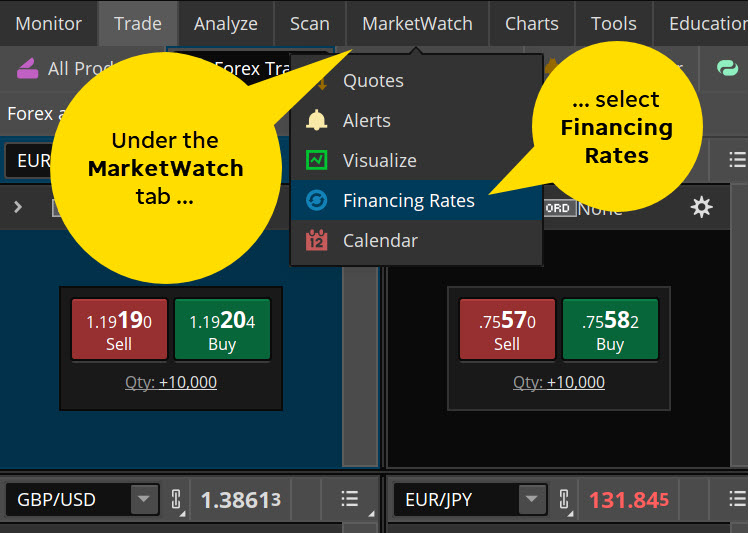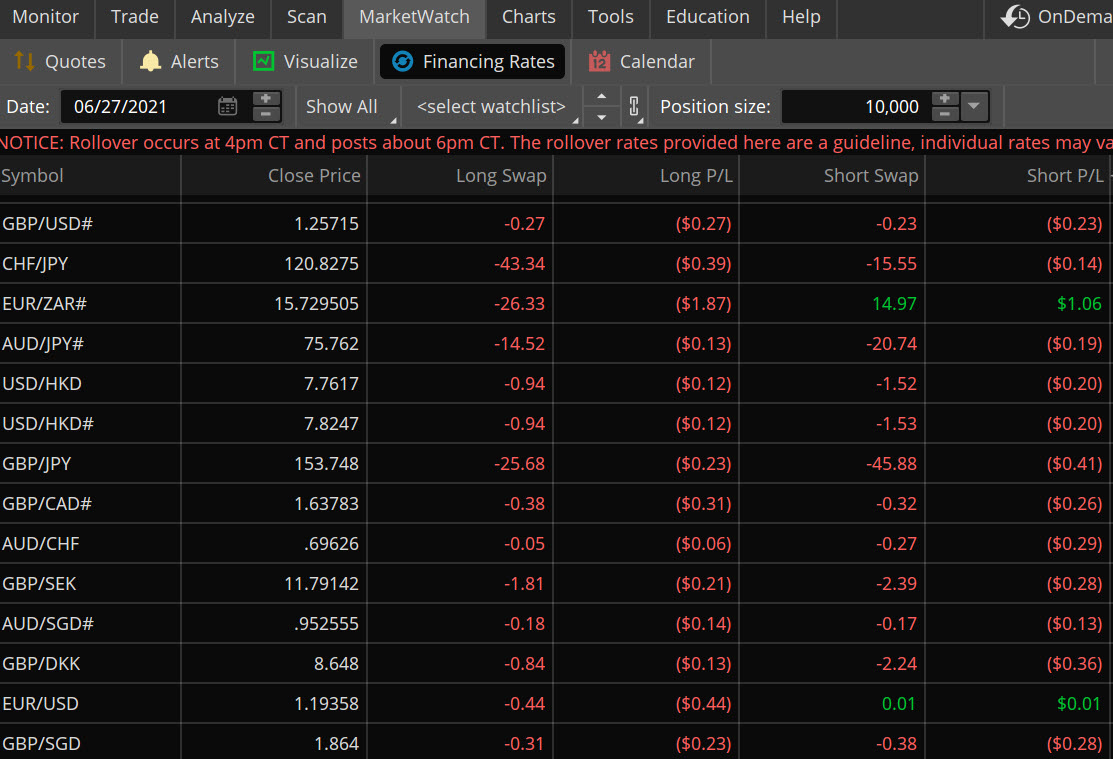When a forex position is carried from one day to the next, the position is adjusted to reflect the interest rate differential between the two currencies. Learn how forex rolling works.

Photo by Getty Images
Key Takeaways
- The financing rate (also known as a “rollover rate” or “roll rate”) is the interest you pay or earn for holding a spot currency overnight
- The rate for a currency pair is based on the interbank interest rate differential between the two currencies
- The current rate for each currency pair listed on the thinkorswim® platform can be found under the MarketWatch tab
Suppose you’ve decided to venture into retail forex investing. You buy a foreign currency and hold the position for about a week.
After a few days, you begin to notice something: Your “open” position seems to be accruing credits (or debits) at the end of each business day. Later in the week, you notice that your account was credited (or debited) three times the seemingly fixed amount.
It begins to dawn upon you that over time, these incremental credits or debits might add up to a much larger amount—one that can alter the value of your investment.
What are these small credits and debits? And why are they happening? Welcome to your first encounter with forex financing rates.
Am I Paying or Earning Interest on My Currencies?
A financing rate (also known as a “rollover rate” or “roll rate”) is the interest you pay or earn for holding a spot currency overnight. These rates aren’t based on central bank rates. Instead, they’re interbank rates: The rates that banks apply when lending money between themselves.
Every time you trade a currency pair, you’re essentially “long” one currency and “short” the other. Each currency in a pair has an interbank interest rate. You earn interest on the currency you’re long, and you pay interest on the currency you’re short. The differential between the two interest rates amounts to your net financing rate.
So, if your long currency has a greater interest rate than the currency you’re short, your net financing rate would yield a credit (a “positive roll”). The opposite scenario would yield a debit (a “negative roll”).
Here’s a hypothetical example: Your forex account is in U.S. dollars. This means all your profits and losses, regardless of the currency pair you’re trading, will be converted to USD. Suppose you’re long 100,000 EUR/USD at the rate of 1.2000. This means you’re long the euro (€100,000) and short its equivalent in USD ($120,000).
Let’s suppose the euro interest rate is 1.25% (an annual rate, which translates into a daily rate of 1.25% / 365 = 0.0034%), and the U.S. dollar has an interest rate of 3% (which translates into a daily rate of 3% / 365 = 0.0082%). Note: These are hypothetical and not actual rates).
- The daily interest on the euro would be (100,000 x 0.000034) = €3.40—this is what you would earn.
- The daily interest on the dollar would be (120,000 x 0.000082) = $9.84—this is what you would pay.
- Now let’s convert €3.40 to USD so we can calculate the financing rate in USD: €3.40 x 1.2000 (the exchange rate) = $4.08.
- To calculate your net financing rate, subtract the interest you’d pay from the interest you’d earn: $4.08 – $9.84 = net financing rate of $5.76.
Your account would be debited $5.76 for holding your 100,000 EUR/USD position over one business day. Note: This particular example illustrates a negative roll. Each currency pair has a different interest rate differential, so some currency pairs may yield a net credit, while others may yield a net debit.
The main point: Financing rate credits and debits will add up, so it’s important to understand how they’ll impact your position over an extended time period. Another important thing to note is that financing rates aren’t necessarily fixed. You’ll need to monitor the rates constantly to be aware of any interest changes.
When Are Financing Rates Applied to My Account?
If your open position is held through the close of the trading day, which is 5 p.m. ET, your position will go through financing.
Financing credits and debits are applied to your account typically around 5:15 to 5:30 p.m. ET. Financing rates are calculated using 365 days, so weekends and holidays are counted toward the financing calculation.
In general, on Wednesdays financing calculations will be three times (“3X”) the normal daily financing calculations, because Wednesdays are typically used to account for weekends. Wednesday 3X financing is not set in stone, however; bank holidays, for example, may alter the financing schedule. If you’re not sure when or how financing is calculated, it’s always good to check with your broker’s schedule to see how and when financing rates will be applied to your account.
Where Can I Find the Financing Rates for Each Currency Pair?
TD Ameritrade clients can view the financing rate for each currency pair rate on the thinkorswim® platform. Under the MarketWatch tab, select Financing Rates (see figure 1).

Selecting Financing Rates will pull up a grid showing the long and short rates for each currency pair listed on thinkorswim (see figure 2). Note: These rates are a sample guideline. Actual rates may vary.

FIGURE 2: SAMPLE FINANCING RATE GRID. Want to check the daily financing rate for your favorite currency pairs? You can find both long and short rates in the grid. But remember: These rates can change daily. For illustrative purposes only.
Bottom Line on Forex Financing and Rolling
Retail forex investing may seem complicated at first. But if you take the time to learn its fundamental mechanics, you may find the forex markets to be accessible and full of opportunities.
Refer to this forex primer to learn more about foreign exchange. Bear in mind that forex trading involves leverage, carries a high level of risk and is not suitable for all investors. Please read the full risk disclosure below to help determine whether forex is appropriate for your investment goals and risk/return profile.
And if you’re interested in taking your forex knowledge to the next level, you might want to watch the video below, which explains interest rate differentials and how a so-called “carry trade” can be constructed in the forex market.

Forex Strategies: The Carry Trade
Doug Ashburn is not a representative of TD Ameritrade, Inc. The material, views, and opinions expressed in this article are solely those of the author and may not be reflective of those held by TD Ameritrade, Inc.
https://tickertape.tdameritrade.com/trading/forex-roll-currency-financing-rates-16137
2021-07-09 14:15:00Z
CBMiVWh0dHBzOi8vdGlja2VydGFwZS50ZGFtZXJpdHJhZGUuY29tL3RyYWRpbmcvZm9yZXgtcm9sbC1jdXJyZW5jeS1maW5hbmNpbmctcmF0ZXMtMTYxMzfSAVlodHRwczovL3RpY2tlcnRhcGUudGRhbWVyaXRyYWRlLmNvbS9hbXAvdHJhZGluZy9mb3JleC1yb2xsLWN1cnJlbmN5LWZpbmFuY2luZy1yYXRlcy0xNjEzNw
Bagikan Berita Ini














0 Response to "Forex Roll Call: How to Calculate Financing Rates on Foreign Exchange Investments - The Ticker Tape"
Post a Comment